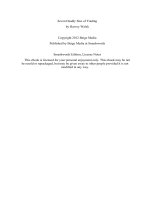- Trang chủ >>
- Khoa Học Tự Nhiên >>
- Vật lý
sloth the seven deadly sins jan 2005
Bạn đang xem bản rút gọn của tài liệu. Xem và tải ngay bản đầy đủ của tài liệu tại đây (1.33 MB, 137 trang )
Sloth
Pride
Michael Eric Dyson
Envy
Joseph Epstein
Anger
Robert A. F. Thurman
Sloth
Wendy Wasserstein
Greed
Phyllis A. Tickle
Gluttony
Francine Prose
Lust
Simon Blackburn
For over a decade, The New York Public Library and Oxford
University Press have annually invited a prominent figure in the
arts and letters to give a series of lectures on a topic of his or her
choice. Subsequently these lectures become the basis of a book
jointly published by the Library and the Press. For 2002 and 2003
the two institutions asked seven noted writers, scholars, and critics
to offer a “meditation on temptation” on one of the seven deadly
sins. Sloth by Wendy Wasserstein is the sixth book from this lecture
series. Previous books from The New York Public Library/Oxford
University Press Lectures are:
The Old World’s New World by C. Vann Woodward
Culture of Complaint: The Fraying of America by Robert Hughes
Witches and Jesuits: Shakespeare’s Macbeth by Garry Wills
Visions of the Future: The Distant Past, Yesterday, Today, Tomorrow
by Robert Heilbroner
Doing Documentary Work by Robert Coles
The Sun, the Genome, and the Internet by Freeman J. Dyson
The Look of Architecture by Witold Rybczynski
Visions of Utopia by Edward Rothstein, Herbert Muschamp,
and Martin E. Marty
Also by Wendy Wasserstein
Uncommon Women and Others (Avon, 1978)
The Heidi Chronicles and Other Plays (Harcourt, 1990)
Bachelor Girls (Knopf, 1984)
The Sisters Rosensweig (Harcourt, 1993)
Pamela's First Musical (Hyperion, 1996)
An American Daughter (Harcourt, 1998)
Shiksa Goddess (Knopf, 2001)
Old Money (Harcourt, 2002)
Sloth
The Seven Deadly Sins
Wendy Wasserstein
The New York Public Library
2005
Oxford New York
Auckland Bangkok Buenos Aires Cape Town Chennai
Dar es Salaam Delhi Hong Kong Istanbul Karachi Kolkata
Kuala Lumpur Madrid Melbourne Mexico City Mumbai Nairobi
São Paulo Shanghai Taipei Tokyo Toronto
Copyright © 2005 by Wendy Wasserstein
Published by Oxford University Press, Inc.
198 Madison Avenue, New York, New York, 10016
www.oup.com
Oxford is a registered trademark of Oxford University Press
All rights reserved. No part of this publication may be reproduced,
stored in a retrieval system, or transmitted, in any form or by any means,
electronic, mechanical, photocopying, recording, or otherwise,
without the prior permission of Oxford University Press.
Library of Congress Cataloging-in-Publication Data
Wasserstein, Wendy.
Sloth / Wendy Wasserstein.
p. cm.– (The Seven Deady Sins)
ISBN-13: 978-0-19-516630-9
ISBN-10: 0-19-516630-2
I. Laziness.
II. Title.
III. Series.
BF485/W38 2005
179'.8—dc22 2004007644
All original artwork © 2005 Serge Bloch / www.marlenaagency.com
Book design by planettheo.com
9 876543 2 1
Printed in the United States of America
on acid-free paper
For Michael Barakiva
and Jeremy Strong, Übersloths
This page intentionally left blank
Contents
EDITOR’S NOTE xi
INTRODUCTION xiii
PART ONE
Why Sloth Works 1
CHAPTER ONE
The Sloth Plan 3
CHAPTER TWO
A Personal History 13
CHAPTER THREE
The Concise History of Sloth 23
CHAPTER FOUR
Sloth Will Change Your Life 33
PART TWO
How to Do It 39
CHAPTER FIVE
Success with Sloth 41
CHAPTER SIX
Welcome to Your Inner Sloth 49
CHAPTER SEVEN
Phase One: Getting Started 57
CHAPTER EIGHT
Phase Two: In the Swing 63
CHAPTER NINE
Plateaus 69
CHAPTER TEN
Maintaining Your Sloth 75
CHAPTER ELEVEN
Medical Breakthrough:
Sloth Is the Way to Good Health! 85
CHAPTER TWELVE
A Pause in the Proceeding 99
CHAPTER THIRTEEN
Überslothdom 103
APPENDIX 111
Editor’s Note
This volume is part of a lecture and book series on the Seven Deadly
Sins cosponsored by The New York Public Library and Oxford
University Press. Our purpose was to invite scholars and writers to
chart the ways we have approached and understood evil, one deadly
sin at a time. Through both historical and contemporary explora-
tions, each writer finds the conceptual and practical challenges that
a deadly sin poses to spirituality, ethics, and everyday life.
The notion of the Seven Deadly Sins did not originate in the
Bible. Sources identify early lists of transgressions classified in the
fourth century by Evagrius of Pontus and then by John of Cassius.
In the sixth century, Gregory the Great formulated the traditional
seven. The sins were ranked by increasing severity, and judged to
be the greatest offenses to the soul and the root of all other sins.
As certain sins were subsumed into others and similar terms were
used interchangeably according to theological review, the list
evolved to include the seven as we know them: Pride, Greed, Lust,
Envy, Gluttony, Anger, and Sloth. To counter these violations,
Christian theologians classified the Seven Heavenly Virtues—the
cardinal: Prudence, Temperance, Justice, Fortitude, and the theo-
logical: Faith, Hope, and Charity. The sins inspired medieval and
xii EDITOR’S NOTE
Renaissance writers including Chaucer, Dante, and Spenser, who
personified the seven in rich and memorable characters. Depic-
tions grew to include associated colors, animals, and punishments
in hell for the deadly offenses. Through history, the famous list
has emerged in theological and philosophical tracts, psychology,
politics, social criticism, popular culture, and art and literature.
Whether the deadly seven to you represent the most common
human foibles or more serious spiritual shortcomings, they stir the
imagination and evoke the inevitable question—what is your
deadly sin?
Our contemporary fascination with these age-old sins, our
struggle against or celebration of them, reveals as much about our
continued desire to define human nature as it does about our
divine aspirations. I hope that this book and its companions invite
the reader to indulge in a similar reflection on vice, virtue, the
spiritual, and the human.
Elda Rotor
Introduction
As long as I can remember, I have been searching for the right self-
improvement plan. I always felt I was on the verge of finding
happiness, if only I could lose weight, develop a better vocabulary
in thirty days, have tighter abdominal muscles and buns, speak
Spanish, achieve inner peace, schedule my day more efficiently,
become more assertive, communicate more clearly, express the full
range of my emotions, get a man to marry me in ten dates, get my
daughter into Harvard at age twelve, understand the subtext of
everything a man said, eat only organic produce, have the heart
rate of a Rollerblader in South Beach, Florida, learn the joy of
having sex in four hundred different positions and loving every one
of them, find my inner child, renew my outer adult, come to terms
with bad things happening to good people, embrace the Hebrew
God, embrace the Christian God, embrace the Muslim God, and
learn to write poetry like the actress Suzanne Somers.
I have followed endless self-improvement regimens. I have
spent thousands of dollars on diet books, exercise books, cooking
books, and spiritual guidance books. They always seem to be the
answer for around three weeks, and then the system starts to
unravel. For instance, when I first read Dr. Atkins’ Diet Revolution,
xiv INTRODUCTION
I was thrilled with the possibility of living on bacon, eggs, and
hunks of brie cheese. My mouth would water at the thought of
thirty links of sausage for breakfast, and I could never imagine
getting tired of saying, “Steak, again?” for dinner. But in the third
week, I saw a piece of bread in a Bon Pain window and began
uncontrollably weeping. I tried to break into the bakery, but the
alarm went off and the fire department arrived. I went back to
read Dr. Atkins for solace, and all I could find were anecdotes and
lists related to this carb-free diet. In fact, if you read most diet
books, there are only around two pages of the daily diet schedule,
and the rest of the book is filled with inspirational affirmations on
the new lifestyle.
After the bakery incident, I realized the key to change wasn’t
just dieting. To truly improve my life, I needed to become a
better, more connected person. Therefore, I bought many man-
uals about relationships and communicating, and tried to really
understand that men come from a different planet and acted
accordingly. But thinking of men as aliens proved to be equally
unsatisfying. I also tried to really communicate and express all
my feelings. When I told my waiter at a Greek coffee shop that
I was concerned about my potential for happiness and attributed
it to a traumatic first grade experience, he didn’t seem to be
interested at all . Next, I really w orked at becoming more assertive,
and now none of my friends talk to me. Each time I looked to
INTRODUCTION xv
another guide for how to have a happier personal life, it only made
me sadder and more isolated. I felt like everyone else was on the
road to self-improvement and I wasn’t. Lifestyle changes should
be simple, the authors of these books swear daily on morning chat
shows and infomercials, if only you follow their guidelines. But
my life wasn’t getting any better, and with each book, I became
more and more defeated.
Having failed at improving my external life, I decided to
focus on inner peace. If I couldn’t learn to communicate, or eat
only protein, then perhaps at least I could become singularly still.
The more I concentrated on tranquility, however, the more
nervous I became. The longer I visualized a stress-free life and the
harmony of one, the harder it was for me to get to sleep at night.
I couldn’t align my shakras. I couldn’t even maintain the
downward dog! Instead, I stayed up all night trying to decode
Linear A and Linear B, the only classical languages that have never
been cracked. If I wasn’t going to be stress-free, I figured I might
as well become the most accomplished person I knew. I read
Wittgenstein for Dummies, Non-Euclidian Geometry for Dummies,
Aramaic for Dummies, Berg Operas for Dummies, Descartes for
Dummies, Post-Cold War Social Theory for Dummies, Defining the
Absolute for Dummies, Writing Computer Viruses for Dummies,
Genetic Cloning for Dummies, and Toward Peace in the Middle
East for Dummies. Although I mastered all of these, my daily life
xvi INTRODUCTION
did not improve. I, frankly, knew too much, and it helped too
little.
I w as on the cusp of accepti ng m ysel f and my life as the failure
that it was when I went to visit my friend Pat Quinn in Los
Angeles. Pat is a Hollywood talent agent, and I was hoping that
her sense of purpose and drive would ignite my own. Driving
along the freeways in Los Angeles is always comforting to me
because I feel everyone is in his or her own isolated bubble. Even
if they’re listening to self-improvement tapes in their SUV
Cadillacs, they’re still driving back and forth on eight lanes of
smoggy concrete. I find that reassuring.
Through Pat’s inspiration, I decided I needed to get a grip
on myself. There was one form of self-improvement I hadn’t yet
explored: bodybuilding. Even in midlife, I thought maybe I could
become the next Mrs. Galaxy. And maybe after that, I could
become governor of California. I liked the idea of firm muscles
rippling on my arms and legs. I wanted to lift two-thousand-
pound weights, because if I could do physical heavy lifting, surely
I could lift myself up spiritually as well. So I went out to the mecca
of body building—Venice Beach, California.
When I arrived at this supposed mecca, instead of finding
my anticipated display of men and women pumping iron, I saw
a seven-mile line of people leading to the Santa Monica pier. The
people were a diverse assortment: all races, young, old, fat, thin,
INTRODUCTION xvii
short, tall, beautiful, and ugly. As I approached them, I noticed
the one thing they all had in common was that they were all
carrying copies of a book titled Sloth: And How to Get It. The
book had just been released, and since I had given up on self-
improvement manuals, I was unaware of its publication. Appar-
ently, on its first day in print, it had sold more copies than the
Bible. My instinct was to ignore these hopefuls and begin my
weight-lifting regimen. But the waiting throng appeared so
enlightened that I decided to just get on line and see what the
hoopla was.
I turned to a man standing next to me and asked, “What’s
everyone here for?” The man responded, “The most influential
author of the world is here, the man who changed my life. I don’t
get up for anything anymore, but I came here to see him.” “Who
is he?” I asked. “The author of this book—Sloth: And How to Get
It,” he answered. “I’ve tried everything, and this is the only one
that’s ever worked.” I said, “I don’t believe these kinds of books
can change your life. And I’ve never heard of this one.” The man
on line explained, “You know, all these self-help books tell you
what to do and how to do it and how much you should be doing
of it. This is the only one that gives you permission not to be
doing anything at all.” I thought about that for a moment and
found the idea to be overwhelmingly appealing. For someone
who had spent her life aspiring to change, even the notion of not
xviii INTRODUCTION
doing anything seemed revolutionary. I decided to take my place
beside the pilgrims.
I waited days as the line wound up to the author. From what
I understand, the progress of the line was impeded by the
author’s insistence on taking naps. When I finally reached him,
he was lying on a hammock wearing light blue pajamas, the
traditional sloth color. There were candy wrappers surrounding
him, and he was watching a suspended plasma TV. I purchased
a copy of his book from the bookseller standing beside him and
handed it to the author for a signing. Instead of a traditional
autograph, he had a rubber stamp with his signature on it. He
looked at me and said only, “I can see sloth will really help you.
You need this.”
I knew he had seen into my inner, overscheduled soul. I went
back to Pat’s apartment, read the book, and it changed my life
forever. I stayed in bed at Pat’s house for a month, until she kicked
me out and changed the locks. During that time, I gave myself
over to sloth and have been practicing it ever since. It is the one
lifestyle manual that I have been able to follow religiously. Even
now, years later, I find that it just gets easier and easier.
Because of my success with sloth, and my extensive failure
with other best-selling self-help manuals, the author asked me to
write this introduction to the following new and revised edition.
Also, he’s too lazy to write it, and I respect that. So what follows
INTRODUCTION xix
is the original Sloth: And How to Get It plus a new chapter on the
übersloths and a brand new activity-counting index.
Good luck! If you follow this book, I’m sure you will find
the same happiness in total resignation that I have. Sloth gives us
the courage to give up searching for self-improvement regimens.
Read this book and you will say good-bye to all those naggy
desires to better yourself. Sloth is the fastest-growing lifestyle
movement in the world, and that’s because it is completely
doable. If you embrace sloth, it’s the last thing you’ll have ever
have to do again.
Wendy Wasserstein
New York City
This page intentionally left blank
Sloth
And How to Get It
Revised Edition
This page intentionally left blank
PART ONE
Why Sloth Works
This page intentionally left blank





![managing the risks of it outsourcing [2005]](https://media.store123doc.com/images/document/14/ne/qk/medium_qka1401862854.jpg)



